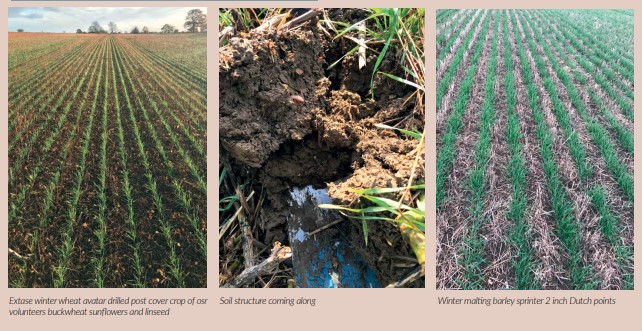Déjà Vu?

Another fun drilling season….I am pleased to say we are drilled up bar about 50 hectares on some poorly drained blackgrassy land which was always on the list to do last. This will now be better off as spring barley. Last season was very difficult, we did not get enough drilled and were always waiting for the promised week of good weather which never materialised. However, the silver lining is that we learnt a huge amount on how to deal with a wet autumn, no tilling on clay. In the long run I think this is a blessing in disguise and which offer more value down the line compared to one harvest with not enough wheat in the ground.
We started drilling on 19th September, getting in about 300ha of winter barley and wheat before the weather broke, on the 23rd the same day as last year. This was all drilled with the sprinter on 2 inch dutch points after spring barley an spring oats. After the rain broke, we had 260ha of cover crop land to get in, as well as 130ha of cultivated land. The cover crop land, after OSR and first wheat consisted of linseed, buckwheat and sunflowers. We managed to chip away in small breaks in the weather for the next month. The cover crop kept the drill running clean and crops look reasonably well now.
There was a lot of slugs to deal with however I hope as we get deeper into this style of farming they will diminish with better soil structure and more beneficials. It was really a revelation being able to drill into nice soil whilst anyone who had cultivated were doing their best to maul crops in, probably causing more soil damage to add on to what was caused last year. The fields now walk beautifully (apart from the odd hammered tramline and headland corner). Water is percolating through the soil profile and the number of worms is staggering.
One thing that has become noticeable in the last few days is that any winter barley crops in the area established direct or with a shallow cultivator pass are generally looking green and well, whereas those established with deeper tillage and ploughing are beginning to show up yellow areas and multiple wheeling’s. More proof that aggressive tillage can often be counterproductive. Our area of cultivated land all ended up being broadcast and harrowed in. It is actually emerging well however the lack of structure in the soil is noticeable when walking, and there is more blackgrass pressure. Not ideal and hopefully the majority of our crops established with no till are proof that this cultivating was recreational.

The rape is generally looking okay, there is about 25ha we will right off and put spring oats in. It has been noticeable the OSR has been much harder to establish after spring barley, compared to early winter wheat and winter barley. Our low risk approach to OSR means the only cost lost on the poor couple of fields is a dose of slug pellets and a £5/ ha graminicide. As all OSR was sown with a companion crop I feel the 30kg/ha N applied at drilling will have been utilised by these, even if the rape itself did not get going.
Regenerative agriculture is reaching an interesting point in its development in the UK. It is becoming more mainstream. This is bringing to the fore some notable issues. What was once a farmer led movement is becoming increasingly saturated with various companies offering “regen” solutions. Unfortunately, these solutions often take the form of various products. I am not saying none of these products don’t ever have a use. However, as this type of farming becomes more mainstream, there is an increasing number of farmers wanting to do it with a large gap in their knowledge.
This leaves opportunity for companies to find a gap in the market to offer advice and products. The issue is if farmers have not gained the full understanding of the 5 basic principles of regen ag they are essentially sitting ducks for companies offering X service or product Y. As the money transfers from conventional to regenerative agriculture we have to be very alert to whom we trust. Many companies offering advice also sell all manner of products so due diligence is needed when choosing who to take advice from. The other worrying aspect of all this is what do these so called “biological/ biostimulant” products do?
They are unregulated and high margin. At least with pesticides (although we don’t want to use them) we know what they can achieve and we also know the detrimental affect the have on the biology we are trying to nurture. I guess as farmers we are always trying to fiddle and improve things however, I am not convinced spending loads of money on gear we don’t really understand is the way to go, despite what the salesmen say. We are however trying a bio-stim, it is cheap and has had good results in numerous independent trials. Far beyond anything else I have seen (in fact many of them seem to have a detrimental affect on yield and do not produce positive MOIC).
As said earlier, some of these things may well have a place. But let us remember the key points for regenerative agriculture. The foundations of the system and most importantly soil. I would strongly urge anyone to understand the basics and get comfortable with them first, that is where the real gains are made. I fear if you simply “outsource” your decision making to vested interests it could end up with disappointment, a bamboozlement of big words and simply replacing a chemical bill with biologicals and high markup trace elements (especially some of the more obscure examples I’ve seen recommended for baffling reasons). The regen movement is supposed to be an alternative to the status quo of high inputs and expensive costs, keep in mind any of these companies offering advice on regenerative farming and selling various products on the back of that is “serviced agronomy mark 2”.
The best investment you can make into making a switch to regenerative farming is in yourself. Read as many books on the subjects as possible, trawl the forums, watch twitter, listen to podcasts, speak to the farmers doing it, download webinars. Find truly independent advisors or at least be clued up when using ones that may have an ulterior angle and get advice from more than one. Use your own mind and trust yourself. If you do not put the effort in you will simply carry on filling up other people’s coffers. Always be wary that the majority of people in this industries job is to make money from you. Get the basics right and the rest will follow.